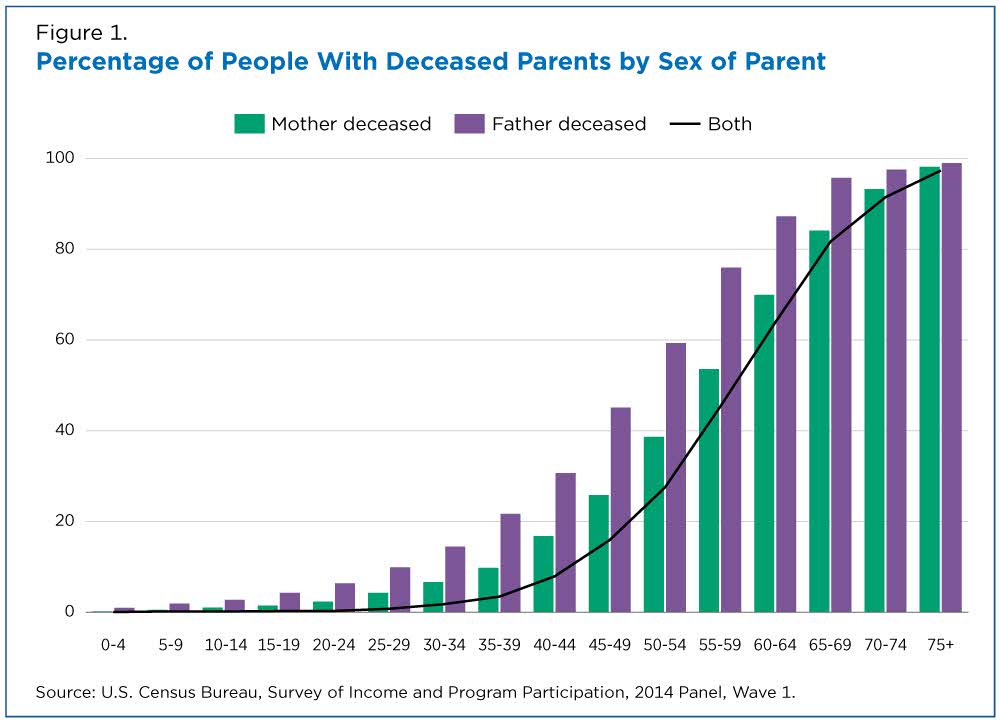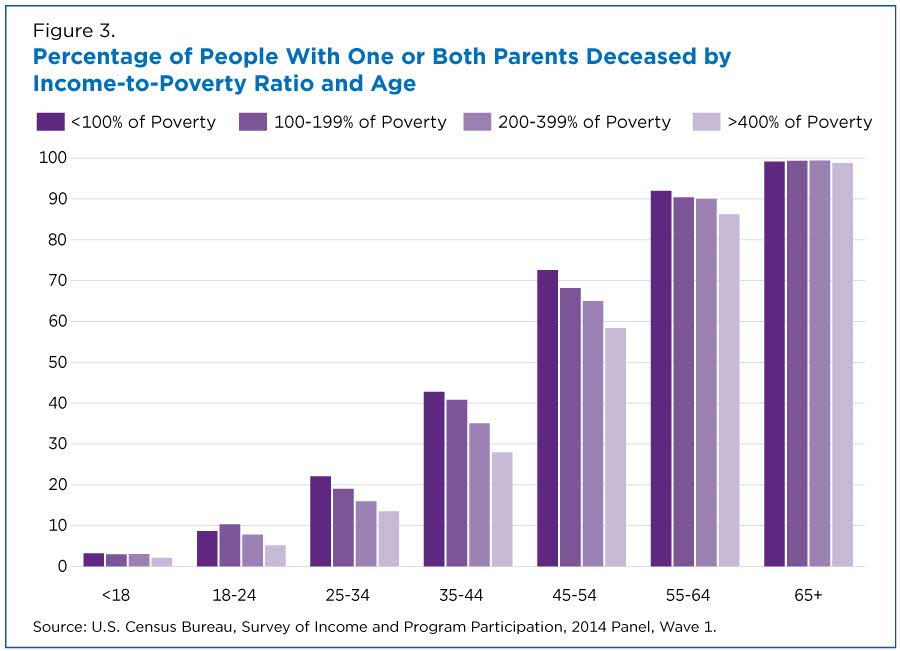Parental Mortality is Linked to a Variety of Socio-economic and Demographic Factors
People lose their fathers earlier in life than their mothers, and the timing of parental loss is linked to factors such as race, educational attainment and poverty status.
For the first time, the 2014 panel of the Survey of Income and Program Participation (SIPP) included a series of questions asking respondents whether their parents were still alive.
Even among individuals ages 55 to 64, where the majority of all adults have lost a parent, a higher percentage of the black population has experienced parental loss.
When taken in combination with socio-economic indicators collected in the SIPP, these nationally representative data offer a new opportunity to evaluate factors related to parental mortality.
A U.S. Census Bureau working paper uses this newly available data to show how demographic factors play a big role in determining when we lose our parents.
Fathers Die Earlier in Their Children’s Lives Than Mothers
Government health data indicate that women live longer, on average, than men. The 2014 SIPP shows how this gap in life expectancy plays out in terms of the timing of parental loss (Figure 1).
For example, among those ages 45 to 49, 26% have lost their mother, while 45% have lost their father. Along these same lines, 7 in 10 of those ages 60 to 64 have a deceased mother, while about 87% have lost their father.
Racial Differences
The 2014 SIPP data also show differences in the timing of parental mortality across racial groupings (Figure 2).
For example, among adults ages 25 to 34, about 15% of the white population and Asian population have lost one or both parents. By contrast, about 17% of the Hispanic population and 24% of the black population have experienced the death of a parent.
Even among individuals ages 55 to 64, where the majority of all adults have lost a parent, a higher percentage of the black population has experienced parental loss.
Differences by Socio-economic Status
Socio-economic factors, such as poverty status, also can influence the timing of parental loss.
A higher percentage of individuals ages 25 to 54 who are living in a household with an income-to-poverty ratio below the Federal Poverty Level (FPL), a national standard based on household size, have lost a parent (Figure 3).
By comparison, those living in wealthier households lose their parents later in life.
For example, among those ages 35 to 44, 43% of those living below the FPL have lost one or both parents, compared to 28% for those living in households with an income-to-poverty ratio of at least 400% of the FPL.
What the New Data Show
Parental loss, which varies by race and socio-economic status, is often accompanied by psychological and material consequences. These statistics demonstrate the way these new SIPP data can help assess how socio-economic and demographic characteristics are associated with parental mortality in the United States.
Subscribe
Our email newsletter is sent out on the day we publish a story. Get an alert directly in your inbox to read, share and blog about our newest stories.
Contact our Public Information Office for media inquiries or interviews.
-
PopulationA Snapshot of the Fast-Growing U.S. Older PopulationOctober 30, 2018The growth of the U.S. population age 65 and older exceeds that of the total population and the population under age 65.
-
PopulationThe Opioid Crisis and Grandparents Raising GrandchildrenApril 22, 2019There is an overlap between states with high percentages of adults age 30 and over caring for grandchildren and states with the highest opioid prescribing rates
-
PopulationThe Nation is Aging, but Some Counties Are Getting YoungerJune 21, 2018A band of counties from Texas to Montana are experiencing a gradual reversal in aging trends.
-
Business and EconomyWhat Is the Nonemployer Marine Economy?April 09, 2025Thirty states had nonemployer businesses in marine economy sectors, including six states in the Midwest with receipts totaling nearly $11 billion in 2022.
-
Business and EconomyEconomic Census Geographic Area Statistics Data Now AvailableApril 07, 2025A new data visualization based on the 2022 Economic Census shows the changing business landscape of 19 economic sectors across the United States.
-
Income and PovertyWhat Sources of Income Do People Rely On?April 02, 2025A new interactive data tool shows income sources for hundreds of demographic and economic characteristic combinations.
-
Business and EconomyBig Improvements to the Annual Integrated Economic Survey (AIES)March 26, 2025The Census Bureau is making several changes and enhancements to capture 2024 economic data based on feedback from last year’s survey.









